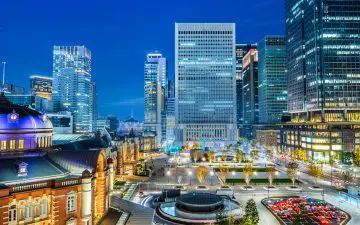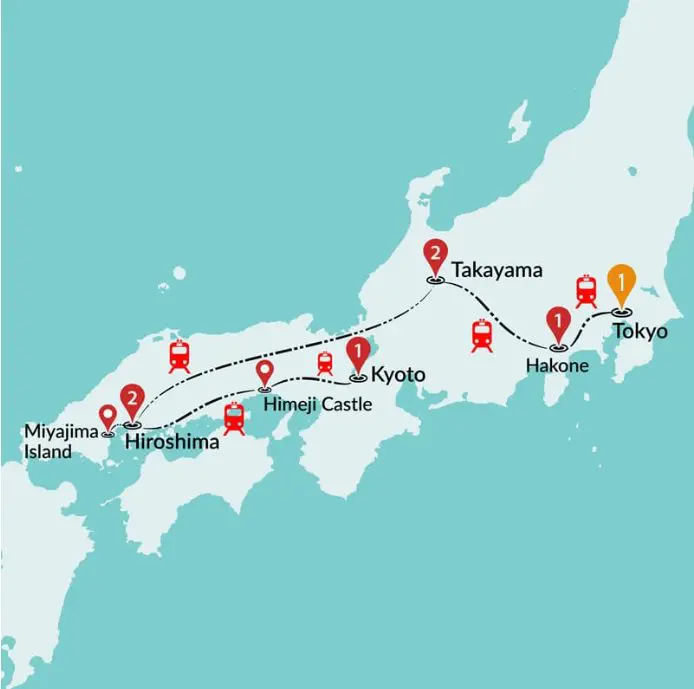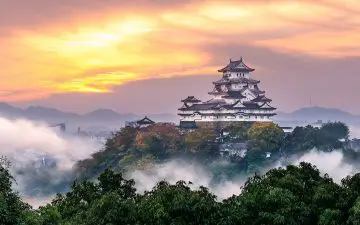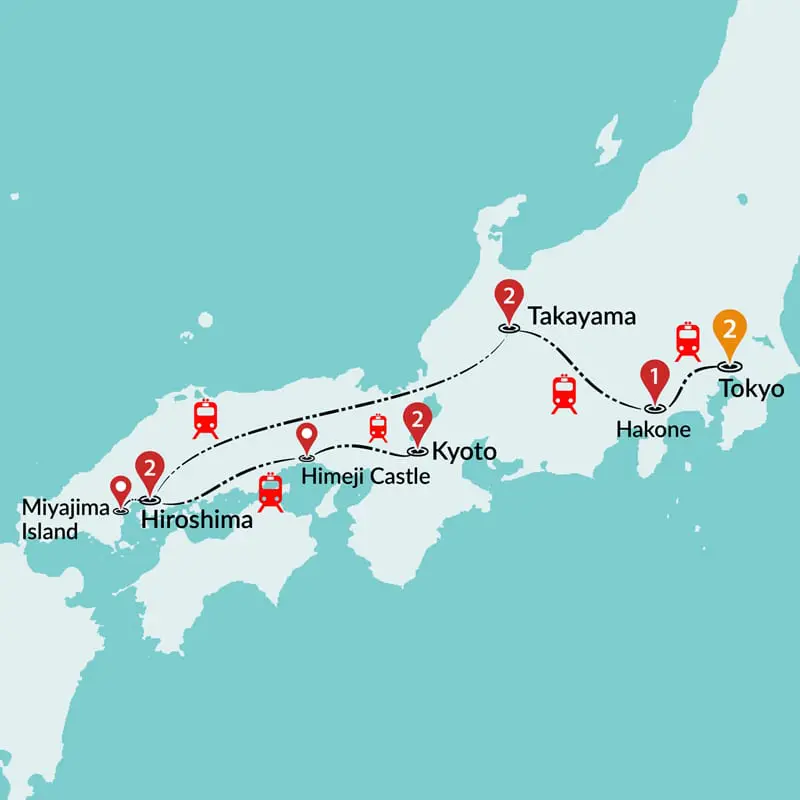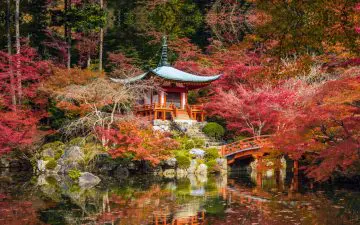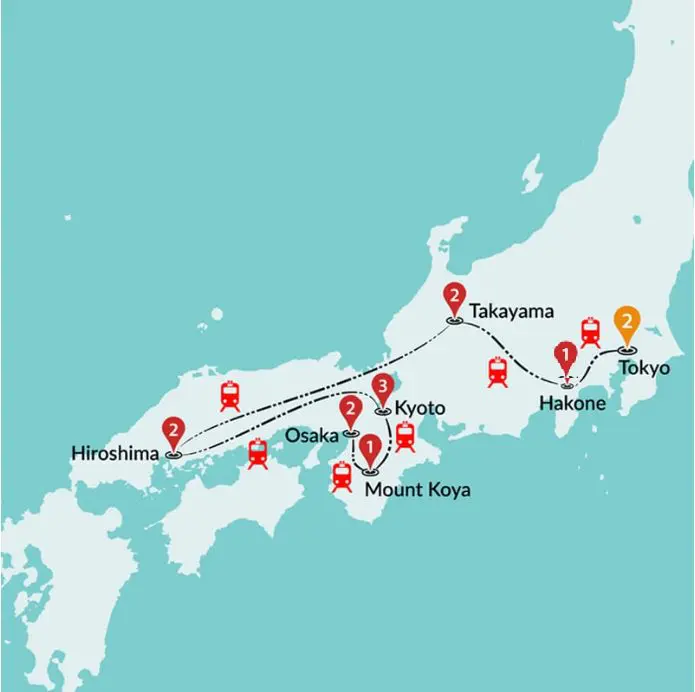Best Time To Visit Japan
The best time to visit Japan is spring and fall when nature is in transition, offering breathtaking views of cherry blossoms or changing leaves across the country. The warm temperatures and dry weather make touring the vast gardens and buzzing markets in the cities comfortable. However, Japan has a diverse land that offers memorable activities every season, making it a popular destination all year round.
June to August, Japan hosts its largest crowds, which means that the major cities like Tokyo and Kyoto are vibrant and joyous. Colorful festivals take place across the country in these months. The blooming land in the countryside offers fascinating views as you travel through the old towns and national parks.
Winter is a quiet season in Japan, except for the ski regions in the north. The snow-covered lands are ideal for spending some leisure time in the resorts and enjoying the iconic onsens. Temperatures are relatively low from December to February, which might be a perfect opportunity for Japan tours if you wish to avoid the heat and humidity.
Why You Should Visit Japan: Japan is a captivating country that offers a unique blend of ancient traditions and modern culture. From the bustling streets of Tokyo to the tranquil beauty of Kyoto, there is something for everyone in Japan. Whether you’re interested in exploring historic temples and shrines, indulging in mouth-watering sushi and ramen, or immersing yourself in the latest fashion and pop culture trends, Japan is the perfect destination.
Things to Consider: Japan is a very safe country, but it’s still important to take precautions to protect your health and safety. This includes getting vaccinated, being aware of your surroundings, and following safety instructions during natural disasters. Japan has a unique culture and customs, and it’s important to be respectful of these when traveling there. This includes following proper etiquette when visiting temples and shrines. While many Japanese people speak some English, it can still be helpful to learn a few basic phrases in Japanese. Japan’s currency is the Japanese yen, and it’s important to have enough cash on hand for smaller transactions.
Monthly Travel Guide For Japan
Travelling in Japan between December and February
Winters in Japan are cool and dry, with an average temperature of 10°C in the major cities such as Tokyo, Osaka, and Kyoto. Snowfall occurs in the northern regions, painting the landscape into powdery white.
The winter months are perfect for enjoying the famous spas and hot springs in Takayama. The skies are as clear as it gets from December to February, offering breathtaking views across the diverse Japanese land. Winter offers the best time to visit Japan in terms of sightseeing.
Many attractions are quiet and peaceful at this time of year, and the crowds tend to increase in the ski regions around February. Packing up for colder weather is recommended if you are traveling to higher altitudes.

Travelling in Japan in March
Temperatures rise to the mid-10s in March, and the trees start to bloom. It is the least busy month of spring and summer, so it might be the best time to visit Japan if you wish to avoid the crowds entirely.

Travelling in Japan in April
April is the season for cherry blossoms, afternoon picnics in the parks, and spectacular sunset in the Japanese countryside. Locals celebrate the awakening of nature across the country, and since most travelers think it is the best time to visit Japan, the outdoors gets crowded.
The weather is pleasant and mild in April. Nights can get chilly, but the rains don’t begin until late May, so the vast countryside of Japan is perfect for visiting on sunny days. Takayama hosts a series of festivals and parades in April, offering a cheerful atmosphere for travelers.

Travelling in Japan in May
May is one of the best months to visit Japan, with dry and warm weather and spectacular vegetation. Mt. Fuji is a must-see attraction around this time. Cherry blossoms are still adorning the trees as spring celebrations continue with the Golden Week in the first week of May. The gardens and parks get crowded in the cities, while the countryside offers a more quiet time.

Travelling in Japan between June and August
Summer is one of the best seasons for trips to Japan. In June, the hot and humid weather arrives, while rain showers begin in most of the country. Temperatures may climb above 30°C in southern cities like Osaka. The land turns even more fertile around this time, making the iconic Japanese gardens the most beautiful sites to visit throughout summer.
The rainy season comes to an end in mid-July. The long and warm days mean comfortable hours of sightseeing. It is the best time to visit Japan for visiting the famous spiritual sites and enjoying walking tours in the bustling cities.
The major cities, especially Kyoto, host vibrant festivals from June to August. Packing up for occasional rains and humid weather is advisable if you are traveling to Japan in the summer.

Travelling in Japan between September and November
The summer crowds are gone in early September, leaving the country in a quiet and cozy atmosphere for the rest of the fall season. The weather is fresh, and temperatures are in late fall. It can be an ideal time to enjoy the markets and streets of Japan. November is the prime time for trips to Japan’s old towns and natural wonders in the countryside.
September can be rainy in most parts of Japan, but the skies clear up in October, giving way to the most breathtaking sunset views. Another iconic scenery takes place in Japan in fall when the leaves turn vibrant shades of red and orange. It is one of the most popular times for Japan tours.

Japan Climate & Weather Guide
| Region | Jan | Feb | Mar | Apr | May | Jun | Jul | Aug | Sep | Oct | Nov | Dec |
|---|---|---|---|---|---|---|---|---|---|---|---|---|
| Tokyo | 10°C | 10°C | 13°C | 18°C | 23°C | 26°C | 30°C | 32°C | 27°C | 21°C | 17°C | 12°C |
| Hakone | 7°C | 8°C | 11°C | 16°C | 20°C | 23°C | 27°C | 28°C | 24°C | 19°C | 15°C | 10°C |
| Takayama | 0°C | 1°C | 6°C | 14°C | 119°C | 22°C | 26°C | 28°C | 23°C | 16°C | 10°C | 4°C |
| Kyoto | 5°C | 6°C | 9°C | 17°C | 22°C | 25°C | 29°C | 31°C | 25°C | 19°C | 14°C | 8°C |
| Hiroshima | 9°C | 10°C | 14°C | 19°C | 24°C | 27°C | 31°C | 33°C | 29°C | 23°C | 17°C | 12°C |
| Osaka | 9°C | 10°C | 13°C | 19°C | 24°C | 28°C | 32°C | 33°C | 29°C | 23°C | 17°C | 12°C |
| Miyajima Island | 7°C | 8°C | 11°C | 17°C | 21°C | 25°C | 29°C | 30°C | 26°C | 21°C | 15°C | 10°C |
| Region | Jan | Feb | Mar | Apr | May | Jun | Jul | Aug | Sep | Oct | Nov | Dec |
|---|---|---|---|---|---|---|---|---|---|---|---|---|
| Tokyo | 50°F | 51°F | 56°F | 66°F | 73°F | 78°F | 85°F | 88°F | 81°F | 71°F | 62°F | 54°F |
| Hakone | 49°F | 51°F | 57°F | 67°F | 75°F | 81°F | 88°F | 91°F | 84°F | 74°F | 63°F | 54°F |
| Takayama | 35°F | 37°F | 46°F | 60°F | 69°F | 75°F | 82°F | 84°F | 75°F | 64°F | 53°F | 41°F |
| Kyoto | 46°F | 48°F | 53°F | 66°F | 73°F | 80°F | 87°F | 89°F | 82°F | 71°F | 60°F | 51°F |
| Hiroshima | 49°F | 51°F | 57°F | 67°F | 75°F | 81°F | 88°F | 91°F | 84°F | 74°F | 63°F | 51°F |
| Osaka | 49°F | 50°F | 56°F | 67°F | 76°F | 82°F | 89°F | 92°F | 84°F | 73°F | 63°F | 54°F |
| Miyajima Island | 44°F | 46°F | 51°F | 62°F | 70°F | 77°F | 85°F | 86°F | 79°F | 69°F | 59°F | 50°F |
| Region | Jan | Feb | Mar | Apr | May | Jun | Jul | Aug | Sep | Oct | Nov | Dec |
|---|---|---|---|---|---|---|---|---|---|---|---|---|
| Tokyo | 50 mm | 70 mm | 100 mm | 120 mm | 140 mm | 170 mm | 130 mm | 140 mm | 210 mm | 190 mm | 90 mm | 50 mm |
| Hakone | 96 mm | 34 mm | 32 mm | 35 mm | 57 mm | 97 mm | 88 mm | 103 mm | 301 mm | 528 mm | 367 mm | 210 mm |
| Takayama | 36 mm | 46 mm | 71 mm | 86 mm | 93 mm | 146 mm | 132 mm | 105 mm | 152 mm | 105 mm | 53 mm | 35mm |
| Kyoto | 56 mm | 67 mm | 109 mm | 149 mm | 145 mm | 233 mm | 203 mm | 147 mm | 201 mm | 127 mm | 80 mm | 54 mm |
| Hiroshima | 40 mm | 60 mm | 100 mm | 160 mm | 150 mm | 250 mm | 230 mm | 100 mm | 190 mm | 100 mm | 60 mm | 40 mm |
| Osaka | 40 mm | 50 mm | 90 mm | 130 mm | 120 mm | 200 mm | 160 mm | 100 mm | 170 mm | 120 mm | 70 mm | 40 mm |
| Miyajima Island | 60 mm | 74 mm | 119 mm | 171 mm | 165 mm | 282 mm | 261 mm | 140 mm | 187 mm | 106 mm | 76 mm | 47mm |
| Region | Jan | Feb | Mar | Apr | May | Jun | Jul | Aug | Sep | Oct | Nov | Dec |
|---|---|---|---|---|---|---|---|---|---|---|---|---|
| Tokyo | 4 | 5 | 1 | 0 | 0 | 0 | 0 | 0 | 0 | 0 | 0 | 1 |
| Hakone | 2 | 2 | 0 | 0 | 0 | 0 | 0 | 0 | 0 | 0 | 0 | 1 |
| Takayama | 3 | 2 | 0 | 0 | 0 | 0 | 0 | 0 | 0 | 0 | 0 | 2 |
| Kyoto | 9 | 7 | 2 | 0 | 0 | 0 | 0 | 0 | 0 | 0 | 0 | 4 |
| Hiroshima | 7 | 4 | 1 | 0 | 0 | 0 | 0 | 0 | 0 | 0 | 0 | 4 |
| Osaka | 12 | 9 | 4 | 0 | 0 | 0 | 0 | 0 | 0 | 0 | 0 | 7 |
| Miyajima Island | 5 | 4 | 1 | 0 | 0 | 0 | 0 | 0 | 0 | 0 | 0 | 3 |
| Region | Jan | Feb | Mar | Apr | May | Jun | Jul | Aug | Sep | Oct | Nov | Dec |
|---|---|---|---|---|---|---|---|---|---|---|---|---|
| Tokyo | 11 km/h | 12 km/h | 12 km/h | 12 km/h | 11 km/h | 10 km/h | 9 km/h | 10 km/h | 10 km/h | 10 km/h | 10 km/h | 10 km/h |
| Hakone | 12 km/h | 12 km/h | 12 km/h | 12 km/h | 11 km/h | 10 km/h | 10 km/h | 10 km/h | 10 km/h | 10 km/h | 10 km/h | 11 km/h |
| Takayama | 12 km/h | 12km/h | 12 km/h | 13 km/h | 12 km/h | 10 km/h | 9 km/h | 10 km/h | 10 km/h | 10 km/h | 10 km/h | 11 km/h |
| Kyoto | 12 km/h | 12 km/h | 12 km/h | 12 km/h | 11 km/h | 10 km/h | 9 km/h | 10 km/h | 9 km/h | 10 km/h | 10 km/h | 11km/h |
| Hiroshima | 11 km/h | 11km/h | 10 km/h | 9 km/h | 8 km/h | 8 km/h | 8 km/h | 8 km/h | 8 km/h | 9 km/h | 10 km/h | 10km/h |
| Osaka | 10 km/h | 10 km/h | 10 km/h | 10 km/h | 9 km/h | 9 km/h | 9 km/h | 9 km/h | 8 km/h | 8 km/h | 8 km/h | 9 km/h |
| Miyajima Island | 11 km/h | 11 km/h | 10 km/h | 10 km/h | 9 km/h | 8 km/h | 8 km/h | 8 km/h | 8 km/h | 9 km/h | 10 km/h | 11 km/h |
When to visit Japan
Visit Tokyo and Kyoto in Summer
Summer offers the best time to visit Japan for its bustling city life and cultural events. Although most of the land experiences rainfall from June to mid-July, the wet weather gives way to a green and blooming landscape in the gardens of Kyoto and Osaka. The days are long and sunny around this time, which will allow you to explore the cities with walking tours, enjoy some leisure time in the parks, and shop for local products in the hopping Japanese markets.
It is also a great time to take train rides to the natural sites surrounding the cities, such as Hakone, where you will experience the best of the blooming countryside. If you are traveling to Kyoto in July, there is a high chance that you will find yourself in the lively parades on the streets throughout the month. Tokyo also has an intriguing portfolio of art and music festivals, not to mention the local bars where you can find all sorts of entertainment that are perfect from June to August.
Tips for visiting Kyoto and Tokyo during summer:
– Be sure to drink plenty of water and take breaks in air-conditioned areas to avoid heat exhaustion.
– Light and breathable clothing is essential during the summer months in Tokyo and Kyoto. Be sure to pack comfortable shoes, a hat, and sunglasses.
– Tokyo and Kyoto have excellent public transportation systems, including buses, trains, and subways. Consider purchasing a transportation pass to save money and make it easier to get around.
– Consider visiting popular attractions early in the morning or late in the afternoon to avoid the heat and crowds.
– Japan is known for its delicious cuisine, and the summer months offer a range of seasonal dishes such as cold noodles, grilled eel, and shaved ice.
– Be sure to follow etiquette when visiting temples and shrines, such as removing your shoes and covering your shoulders.
Trips to Japan in Spring and Fall
Traveling to Japan has a lot to offer in spring and fall when outdoor activities are enjoyable in the cities and the vast countryside. From late March, the iconic cherry blossoms cover the zen gardens and city parks, turning the outdoors into a natural paradise. It is the best time to visit Japan since locals take advantage of the warm weather to enjoy the great outdoors. You will have a chance to witness the local culture at its best.
The fall season offers an equally pleasant time, only less busy due to the end of the holiday season. One of the highlight activities from September to December is traveling through the sacred lands of Mount Koya to visit the age-old temples and monasteries. The red and orange shades covering the country create a cozy atmosphere, making zen gardens and Buddhist rituals even more tranquil at this time of year. If you wish to add some cultural knowledge to your vacation, Hiroshima is perfect for visiting in the mild temperatures of spring and fall. Our Ultimate Japan trip offers a stop at the highlight attractions in Japan and the opportunity to witness the picturesque countryside in these seasons.
Tips for visiting Japan in spring and fall:
– Be prepared for occasional rain, especially in the spring.
– Pack clothing appropriate for the season, with layers for cooler days and evenings.
– Japan has a range of festivals and cultural events during the spring and fall. In the spring, the cherry blossom festivals are a must-see, while in the fall, the autumn foliage festivals are equally beautiful. Other festivals include the Sanja Matsuri in Tokyo in May, and the Jidai Matsuri in Kyoto in October.
– Japan is known for its delicious cuisine, and the spring and fall offer unique seasonal dishes. In the spring, try sakura-themed treats like sakura mochi, while in the fall, chestnuts and sweet potatoes are popular. Be sure to also try regional specialties like sushi, ramen, and tempura.
Japan FAQ
What’s the best time to visit Japan for budget travellers?
The best time to visit Japan for budget travellers depends on a few factors, such as the season, events happening in the country, and the cost of flights and accommodation. Generally, the cheapest time to visit Japan is during the low season, which is from December to February (excluding the New Year’s holiday period), and from June to August (excluding the Obon holiday period).
When is the best time to visit Tokyo?
Spring is one of the most popular times to visit Tokyo because of the cherry blossom season. The city is blanketed in pink and white flowers, and there are many festivals and events celebrating the blooms. However, this is also peak tourist season, so expect higher prices and larger crowds.
Summer in Tokyo is hot and humid, but it’s also when you can experience many of the city’s outdoor festivals and events, such as fireworks displays and street food festivals. This is also the time when schools are out and many locals take their vacations, so popular tourist spots can be very crowded.
What is the best month to visit Japan to beat the crowds?
If you’re looking to beat the crowds and avoid the busiest tourist season in Japan, you may want to consider visiting during the low season. The low season is generally from December to February (excluding the New Year’s holiday period) and from June to August (excluding the Obon holiday period).
Of these months, January and February are typically the least crowded, with fewer tourists and shorter lines at popular attractions. While the weather can be cold and snowy, it’s a great time to experience winter sports and enjoy winter festivals like the Sapporo Snow Festival.
When is the best time to experience Japanese culture?
Japan has a rich culture that can be experienced year-round, but there are certain times of the year when cultural events and traditions are particularly prominent. Summer in Japan is a time for festivals and fireworks displays.
You can experience traditional dance and music performances at events like the Gion Matsuri in Kyoto or the Awa Odori in Tokushima. all is the season of autumn leaves, and it’s a great time to visit temples and shrines that are surrounded by colorful foliage. You can also experience traditional harvest festivals like the Takayama Matsuri or the Kurama Fire Festival.
When is the cherry blossom season in Japan?
The cherry blossom season, also known as sakura season, in Japan typically occurs from late March to early May, depending on the location and weather conditions. The first blossoms usually appear in the southern part of Japan, such as in Okinawa, in late March, and then gradually move northward, reaching Tokyo in early April and Hokkaido in early May
When is the autumn foliage season in Japan?
The autumn foliage season in Japan typically occurs from late October to early December, depending on the location and elevation. The leaves usually start changing colors in the northern regions of Hokkaido and Tohoku in late September and gradually move southward, reaching the Kanto and Kansai regions in November.
How many days do you need to visit Japan?
The number of days you need to visit Japan depends on your travel goals and interests. If you’re interested in exploring Tokyo and other major cities, you could spend at least 7-10 days in Japan. This would allow you to see some of the top attractions, experience the local cuisine, and get a feel for the unique culture of Japan. If you’re interested in exploring more of Japan’s natural beauty and historic sites, you may want to spend at least 2-3 weeks in Japan.
What is the rainy season in Japan?
The rainy season in Japan, also known as “tsuyu” or “baiyu,” typically occurs in early June and lasts for about a month. During this time, Japan experiences a high amount of rainfall, particularly in the central and southern regions. The rainy season is caused by warm, moist air from the Pacific Ocean meeting cool air from Siberia, resulting in heavy rain and high humidity.
What is the rainy season in Japan?
The rainy season in Japan, also known as “tsuyu” or “baiyu,” typically occurs in early June and lasts for about a month. During this time, Japan experiences a high amount of rainfall, particularly in the central and southern regions. The rainy season is caused by warm, moist air from the Pacific Ocean meeting cool air from Siberia, resulting in heavy rain and high humidity.
What is the coldest month in Japan?
The coldest month in Japan varies depending on the region. In northern Japan, the coldest month is typically January, while in central and southern Japan, it is usually February. During these months, temperatures can drop to below freezing, especially at night.
What are the best cities to visit in Japan?
Tokyo: The capital city of Japan is a bustling metropolis with an array of shopping, dining, and entertainment options. Kyoto: Known as the cultural heart of Japan, Kyoto is home to hundreds of temples, shrines, and gardens. Osaka: The food capital of Japan, Osaka is famous for its street food, delicious restaurants, and lively nightlife. Hiroshima: This city is known for its tragic history and inspiring resilience. Sapporo: The largest city in the northern island of Hokkaido, Sapporo is a popular destination for winter sports enthusiasts.
Is it safe to travel to Japan?
Yes, Japan is generally considered a safe country for travelers. It has a low crime rate and is known for its strict enforcement of laws and regulations. Visitors can feel safe walking around at night, using public transportation, and exploring the country’s many attractions.
However, like any destination, there are certain risks to be aware of when traveling to Japan. Natural disasters, such as earthquakes and typhoons, can occur, particularly during certain seasons. It’s important to stay informed of weather conditions and follow the advice of local authorities.
What are the most beautiful places in Japan?
The iconic Mount Fuji is Japan’s tallest mountain and a UNESCO World Heritage Site. Kyoto is home to many historic districts with beautiful traditional architecture, such as Gion, Higashiyama, and Arashiyama. Located in the Japanese Alps, Takayama is a picturesque town known for its beautifully preserved old town, traditional crafts, and festivals. This small island near Hiroshima is home to the famous Itsukushima Shrine with its stunning torii gate, as well as beautiful hiking trails and wildlife.
Does Japan have nightlife?
Yes, Japan has a vibrant nightlife scene, particularly in major cities like Tokyo, Osaka, and Kyoto. From bars and nightclubs to karaoke and live music venues, there is something for everyone.
In Tokyo, the neighborhoods of Shibuya, Shinjuku, and Roppongi are known for their lively nightlife scenes. Visitors can find everything from small bars and izakayas (Japanese pubs) to large nightclubs and live music venues. Many of these establishments stay open until the early hours of the morning, making Tokyo a popular destination for night owls.
Which airlines fly directly into Japan?
There are many airlines that offer direct flights to Japan from various cities around the world. Here are some of the major airlines that fly directly to Japan: All Nippon Airways (ANA), Japan Airlines (JAL), Delta Air Lines, United Airlines, American Airlines, British Airways, Air Canada, Cathay Pacific
What to wear in Japan?
Conservative and modest clothing is generally preferred. This means avoiding clothing that is too revealing, such as shorts or tank tops. Business attire is often required in formal settings, such as meetings or job interviews. This typically means a suit and tie for men and conservative dress or pantsuit for women. When visiting religious sites or attending formal events, it’s best to wear more formal attire, such as a dress or suit. Comfortable, casual clothing is appropriate for most everyday situations. Jeans, t-shirts, and sneakers are common. Shoes should be easy to slip on and off, as it is customary to remove shoes before entering many buildings, including homes, temples, and some restaurants.
What is Japan famous for?
Japan is renowned for its high-tech gadgets, robotics, and advancements in electronics and engineering. Japan has produced some of the most popular and widely recognized animated shows and graphic novels in the world. Japanese cuisine is famous for its sushi, ramen, udon noodles, and many other delicious dishes. Japan’s beautiful sakura (cherry blossom) trees draw millions of visitors from around the world each year. Japan has many beautiful and historic temples and shrines, including the famous Golden Pavilion, Fushimi Inari Shrine, and Senso-ji Temple.
What is the best time to eat delicious food in Japan?
In Japan, many restaurants and food establishments serve delicious food throughout the day, but there are a few specific times that are considered the best for certain types of food. For example, sushi and sashimi are often enjoyed at lunchtime, as many sushi restaurants offer lunchtime specials or bento boxes that include a variety of seafood. Ramen, one of Japan’s most popular dishes, is often enjoyed as a late-night snack after a night out or as a quick meal during lunchtime.
Do you need a visa to visit Japan?
Whether or not you need a visa to visit Japan depends on your nationality and the length of your intended stay.
Nationals from around 70 countries, including the United States, Canada, Australia, and most European countries, do not need a visa for stays of up to 90 days as tourists or for business purposes. These nationals will be granted a visa waiver upon arrival in Japan. If you are unsure whether you need a visa or not, you should check with the Japanese embassy or consulate in your home country.
Japan by Season

Winter
Japan’s temples and shrines take on a special charm during the winter months, with snow-covered pagodas and torii gates. Some of the most popular temples and shrines to visit in Japan during the winter include Kiyomizudera in Kyoto and Sensoji Temple in Tokyo.
The country’s winter landscape is a wonderland of snow-capped mountains, steaming hot springs, and plum blossoms. Make sure to include popular winter activities such as skiing, snowboarding, hot spring baths, and enjoying seasonal delicacies such as seafood and warm sake.
Best Things to do in Japan in winter:
Relax in the natural hot water in a traditional Japanese onsen, while taking in the snow-covered scenery. Admire the famous illuminations in Tokyo and Osaka.

Spring
Spring in Japan is synonymous with cherry blossom season, which is a breathtakingly beautiful time of the year when the streets and parks are covered in pink and white blooms.
Perfect weather for exploring Japan’s bustling cities and soaking in the vibrant street fashion and trendy neighborhoods.
Best Things to do in Japan in spring:
Enjoy hanami, or flower viewing, and gather under the blooming cherry trees to have picnics. Experience traditional festivals such as the Kyoto geisha dances.

Summer
Japan’s picturesque countryside is a popular attraction during the summer, with its lush green mountains and scenic hiking trails.
Summer in Japan is also the perfect time to indulge in seasonal treats such as kakigori and cold soba noodles, making it a foodie’s paradise.
Best Things to do in Japan in the summer:
Attend the famous Gion Matsuri in Kyoto. Visit Tokyo Disneyland and Universal Studios Japan, and indulge in seasonal food and drinks. Revel in the hiking community of Mt. Fuji.

Autumn
One of the most popular activities in the fall is momiji-gari, or maple leaf viewing, where you can witness the beautiful colors of the autumn foliage. Some of the best places to enjoy autumn leaves in Japan include Kyoto’s temples and gardens.
Fall is an excellent season for foodies to visit Japan, with a range of seasonal delicacies such as chestnuts, sweet potatoes, and Matsutake mushrooms.
Best Things to do in Japan in autumn:
Attend the famous Takayama Festival in Gifu Prefecture and the Jidai Matsuri in Kyoto. Engage in some moon-viewing in Japan with the locals.
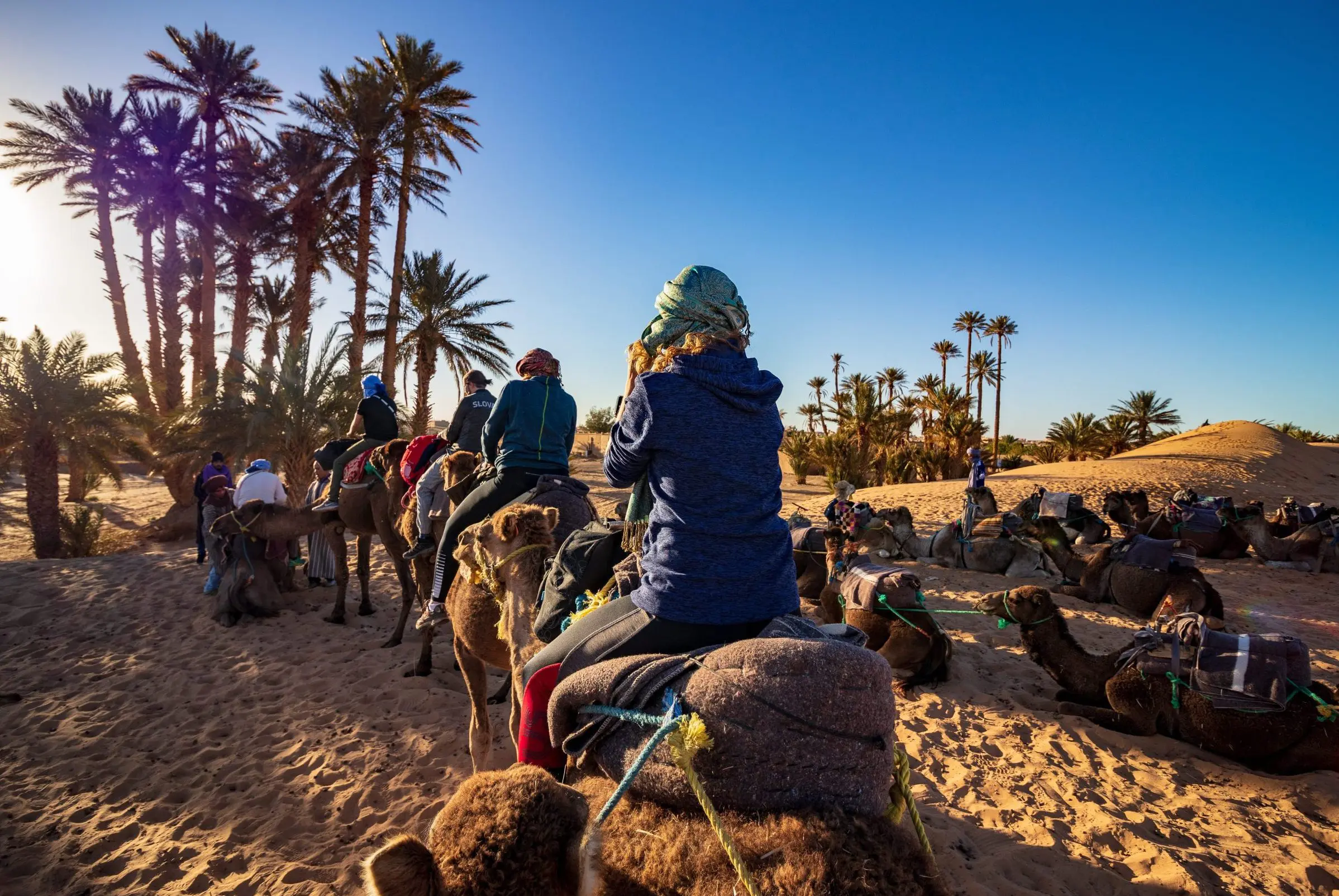 Summer Sale: 45% Off
Summer Sale: 45% Off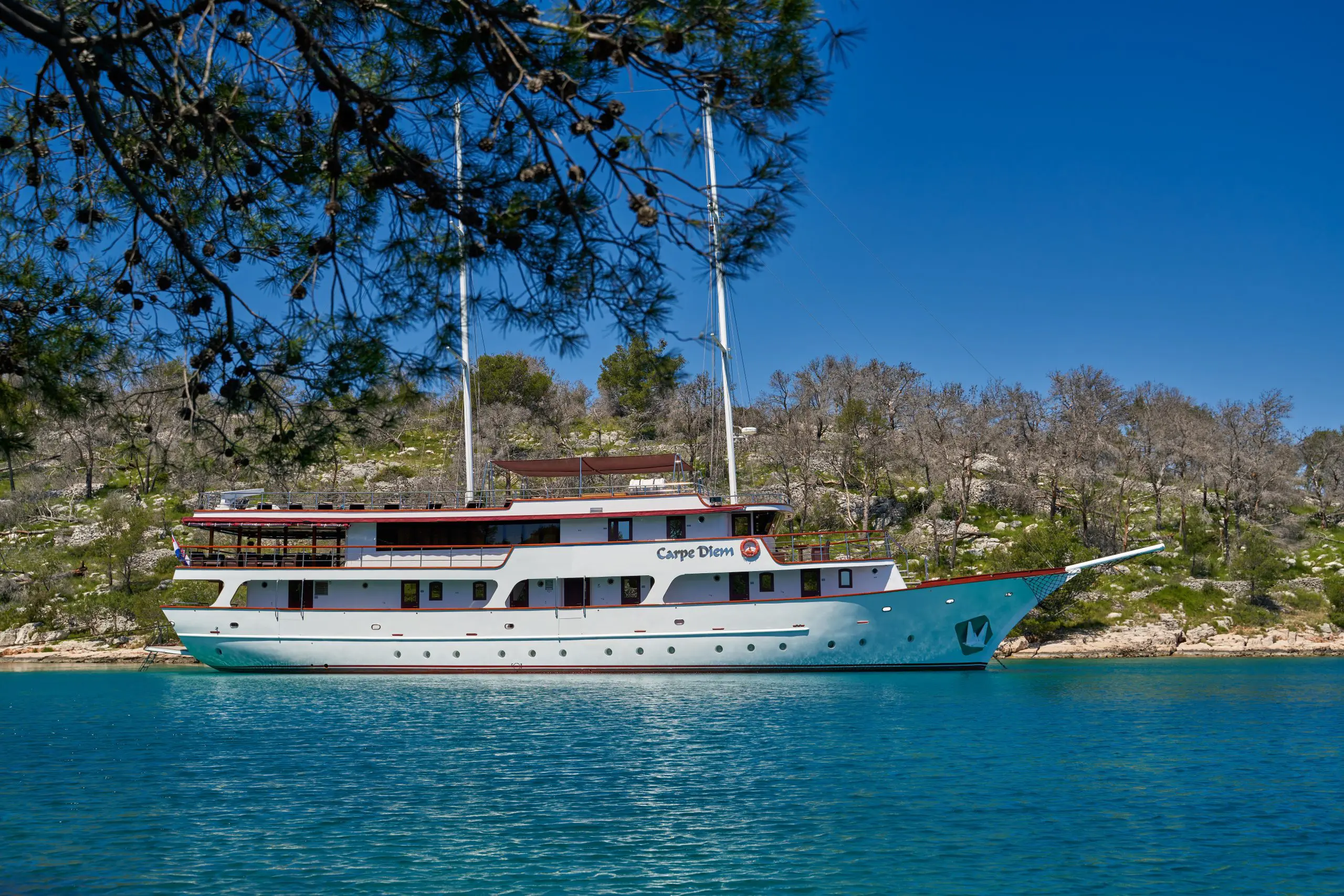 Croatia Sailing : 45% Off
Croatia Sailing : 45% Off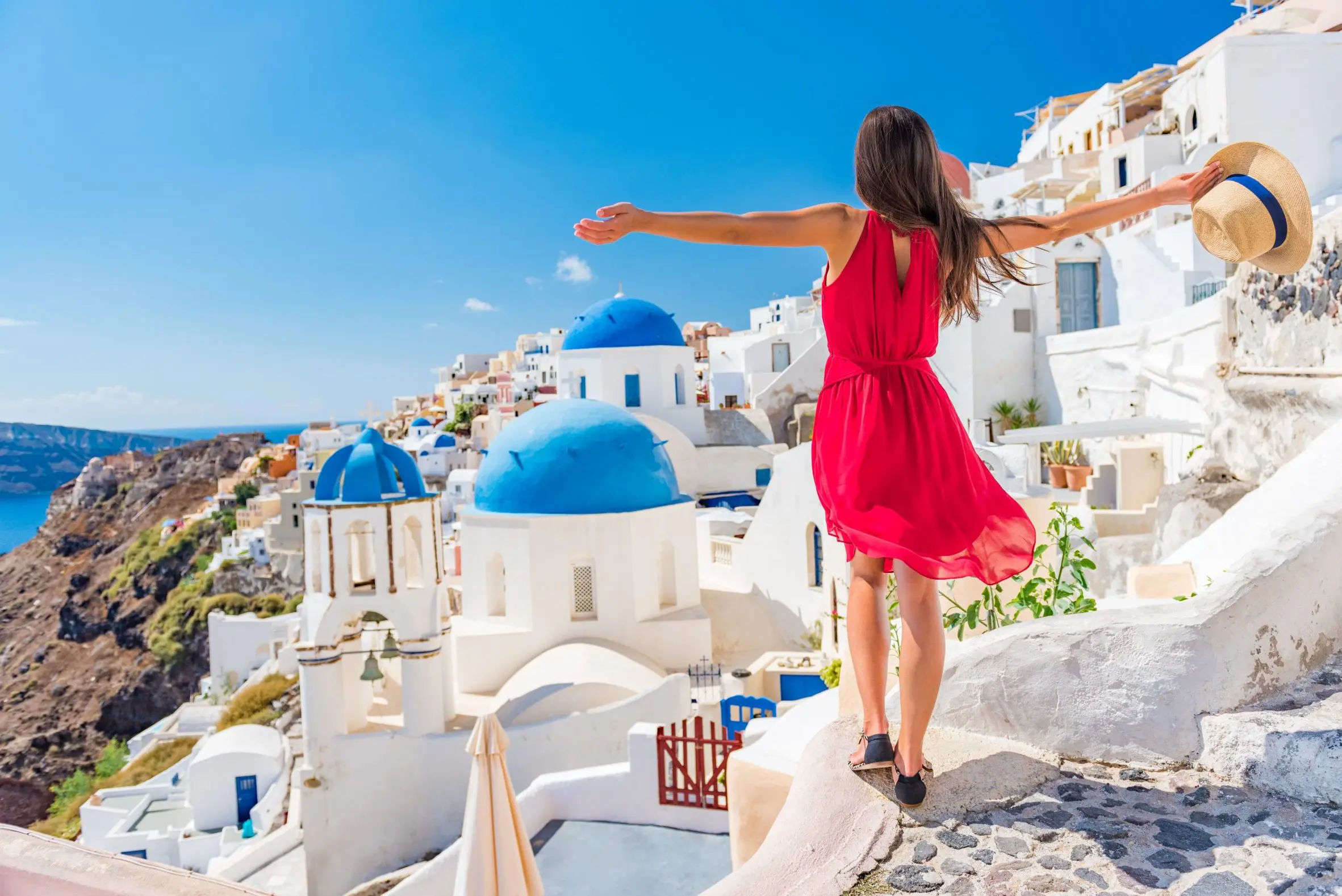 Greece Trips : Save 45%
Greece Trips : Save 45%  Central & Eastern Europe Tours: 45% Off
Central & Eastern Europe Tours: 45% Off  Why Travel Talk
Why Travel Talk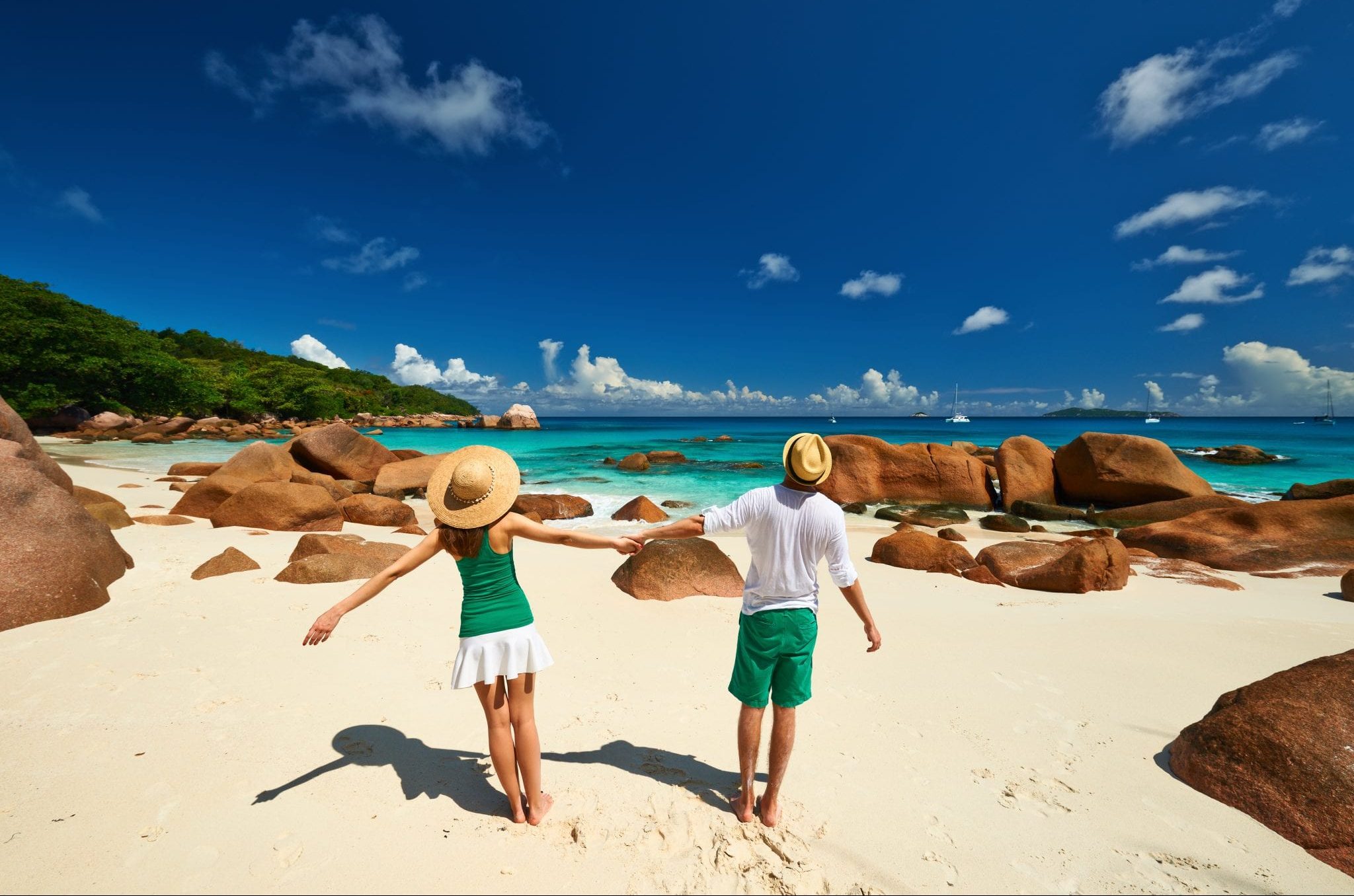 Travel Talk Blog
Travel Talk Blog Responsible Travel
Responsible Travel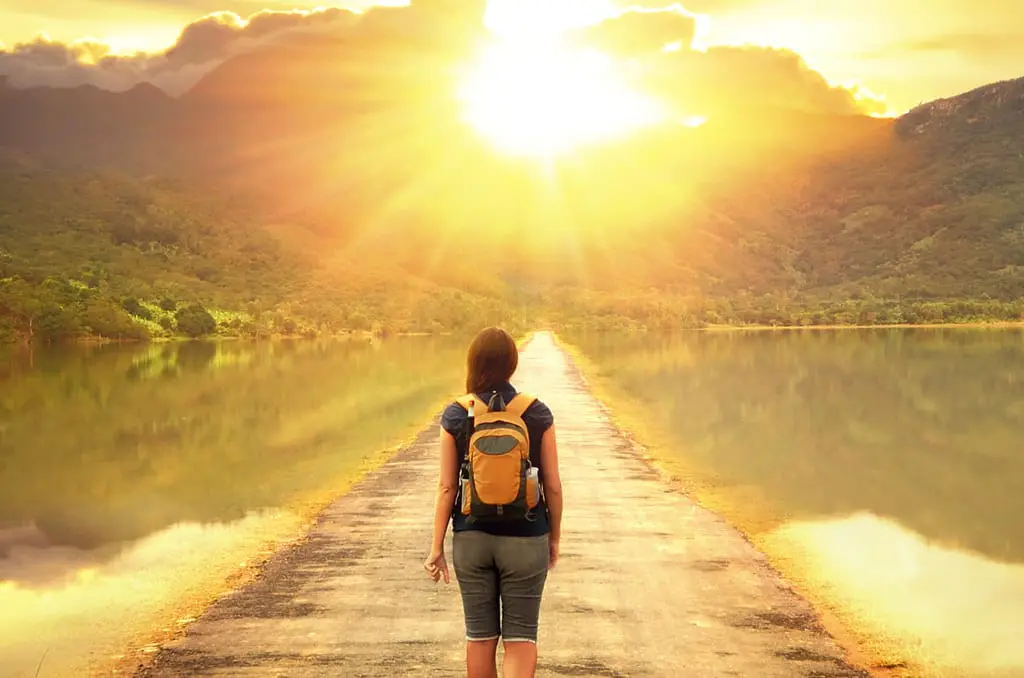 Fair Travels with Travel Talk
Fair Travels with Travel Talk